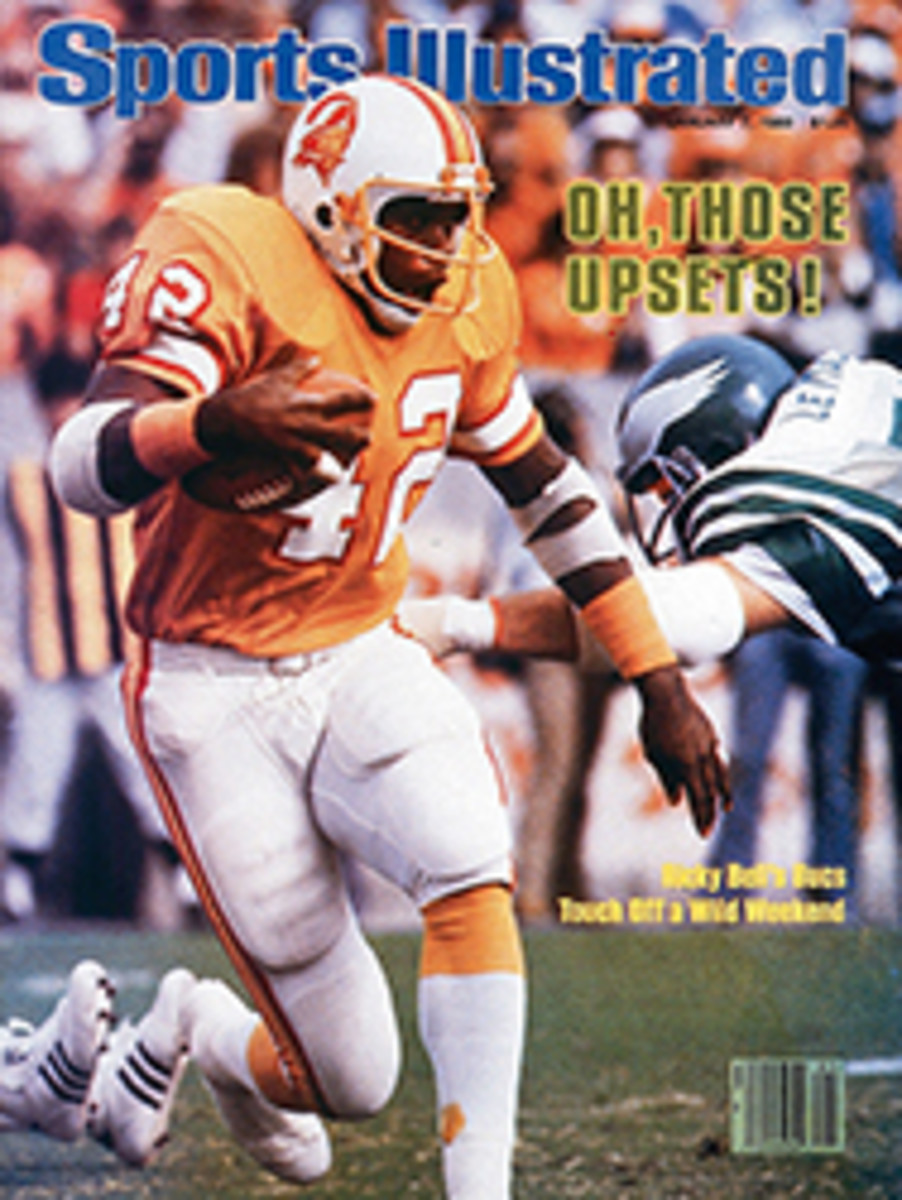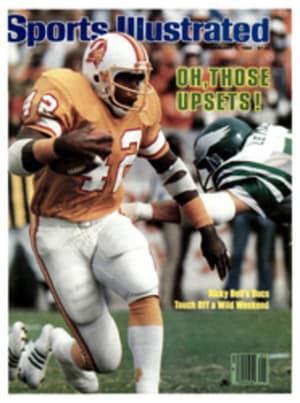
SCORECARD
PUNISHING THE PUGILISTS
Two weeks ago, after a 4-3 victory by the Boston Bruins over the New York Rangers in Madison Square Garden, tempers flared between the two teams. Spectators began to throw debris and scream at the Boston players, and one particularly rabid Ranger fan punched Bruin Stan Jonathan, who had scored the winning goal, then grabbed Jonathan's stick and began to wave it at the Bruins. In an instant several Boston players rushed into the stands to have it out with the fans. The ugly and frightening scene lasted more than 15 minutes.
There long have been outcries against the violent brawling that characterizes play in the NHL. It is bad enough that players attack each other during games, but the invasion of the stands is intolerable. And spectators must not be allowed to harm the players.
As for fighting, putting players in a penalty box is obviously not doing the job of preventing fights that are not only bad in themselves but also have the side effect of creating a combative atmosphere among fans.
One hockey expert, who loves and cares about the game, has suggested that any player who drops his gloves and engages in a fight be automatically expelled for the rest of that game and suspended for the next. A second fight would draw another expulsion and a two-game suspension; a third fight, expulsion and a three-game suspension. Such a carryover penalty would not only discourage players from fisticuffs but also might quiet down fans, who would not encourage their favorites to fight, lest they be suspended. It may not be the ultimate solution, but it's the best one we've heard.
HEIDEN SEEKS
The speed-skating oval at the Wisconsin State Fairgrounds in West Allis, just outside Milwaukee, is not one of the world's great sports venues. It is in a seedy setting, next to a superhighway with a cement plant looming nearby. And, since the rink was opened in 1966, a world record had never been set there, a startling fact considering that it has been home ice for such American skating stars as Olympic medalists Terry McDermott, Anne Henning, Sheila Young, Dianne Holum, Peter Mueller and Leah Poulos Mueller, to say nothing of the Heidens, Beth and her incomparable brother, Eric, holder of every men's world championship.
The reason for the absence of records is that though the rink is adequately constructed, it is located in an area of industrial pollution. This tends to make the ice coarser. Prevailing winds at West Allis are also strong.
But last weekend there was at last a record-breaking performance at West Allis. Eric Heiden, 21, flashed through a stunning 1,000-meter race at the Olympic Trials in 1:14.37, which was .62 second faster than the world record he set on the fast ice at the Savalan rink in Norway. An appreciative crowd of 3,000, the largest ever at a West Allis event, stood and applauded. Other speed skaters were astonished. Even Heiden himself was impressed. "I guess it was just a perfect set of conditions," he said, "and it psyched me up more than usual. I wish it counted officially."
Doesn't count officially? Well, there was confusion about whether or not the International Skating Union, which governs speed skating, would recognize the record. Usually the ISU will sanction only records set at international competitions. It will, however, stand as an American record, probably for at least a quarter century.
ROMAN NUMERALS
Who is the highest-paid athlete of all time? Muhammad Ali? Arnold Palmer? Maybe Nolan Ryan? Or Bjorn Borg? Or Laffit Pincay Jr.? How about Gaius Appuleius Diodes?
Diocles was a Spanish-born Roman charioteer, the Billy Haughton of his time, who from 122 to 146 A.D. won 1,462 of the 4,257 chariot races he entered. In those 24 years Diocles earned more than 35 million sesterces. Most of those winnings probably came from the treasuries of the emperors Hadrian (117-138) and Antoninus Pius (138-161), who were in power during Diodes' career.
A sesterce, of course, was worth one quarter of a denarius, another ancient Roman coin, and there is no reliable way to determine what the value of either would be in modern currency. But consider that during a period of rampant inflation some 150 years after Diocles' heyday, the emperor Diocletian imposed a wage freeze dictating that stonemasons be paid no more than 200 sesterces per day, camel drivers and water bearers 100 and shepherds 80 sesterces. That makes Diocles' pre-inflation 4,000 a day even more impressive.
This information comes courtesy of David Matz, who culled it from Latin inscriptions on stone plaques that are now in Roman museums. An ancient-history teacher at the Breck School in Minneapolis, Matz' hobby is ancient athletics, a subject he says has been unjustly neglected. "Most people studying ancient civilizations are not very interested in sports," says Matz, who also is an assistant coach for girls' Softball and boys' football at Breck.
According to the 32-year-old Matz, who has a Ph.D. in Latin from the University of Minnesota, chariot racing was the No. 1 spectator sport in Rome, which boasted the famous Circus Maximus racecourse. There were up to 12 chariots in each race, which usually covered seven laps, or about six miles. Even if Diocles got to keep only a small part of his earnings after sharing them with the owners of the horses, he was still among Rome's wealthiest citizens. And he didn't even have an agent.
THE SCANDAL SPREADS
At the time of our last report on the scandal involving athletes who received bogus credits from summer extension courses offered by Rocky Mountain College and Ottawa University (SI, Dec. 24), only the football team at Arizona State and the football and basketball teams at New Mexico had been forced to forfeit games because they had used ineligible players. Although three football players from Oregon and a basketball player from Utah had been enrolled in the Ottawa course, neither of those schools, after investigating the facts, had found any wrongdoing.
During Christmas week it was learned that neither Rock Richmond nor Mike Honeycutt, Oregon players who received credit for the course, had attended classes or done any work. Furthermore, freshman Paul Perez had not only been enrolled in the Ottawa course but, along with freshman Paul Sanborn, had also received credit for such other courses as Intermediate Weight Lifting and Recreation Field Work, taught at Los Angeles Valley Community College.
In the wake of these revelations, Oregon Assistant Football Coach John Becker, the man who apparently arranged the credits from Ottawa and L.A. Valley, resigned. It turned out that Becker had formerly been head coach at L.A. Valley and had worked in the physical education department there with Earle P. Durley, the instructor for the Ottawa course, Current Problems and Principles in Coaching Athletics. Before that, Becker and Durley had been colleagues on the New Mexico football staff. (Two other Oregon assistant coaches, Bob McCray and Andy Christoff, are also former members of the New Mexico staff.) Oregon Coach Rich Brooks says that Durley told him that Durley had arranged for the players to receive the credits because of his friendship with Becker.
As a result, Oregon, 6-5 in football this season, will probably forfeit its games, the second Pac-10 school—Arizona State was the first—to do so. But not the last. After Oregon State discovered that one of its players, Leroy Edwards, had been in the Ottawa course, it did further checking and found a phony grade from a Florida junior college on Edwards' record. Thus Oregon State, which had seen its record improve from 1-10 to 4-7 after "forfeit" wins over New Mexico, Arizona State and San Jose State, may find itself with a record of 0-11.
Meanwhile Utah, which had similarly exonerated basketball player Danny Vranes who had taken the Ottawa course by correspondence, reversed itself and declared Vranes ineligible for the fall quarter. As a result, the Utes may have to forfeit five basketball victories.
NEW MATH
Everyone knows that sports fans love numbers. What would baseball be without ERAs, RBIs, batting averages and strikeout totals, or football without yards per carry, pass-completion percentages and punting averages? Now golf, which has always been dignified by its paucity of statistics, has succumbed to the pressure of the numbers game.
The PGA tour has announced that this year it will keep round-by-round and cumulative statistics in eight categories. Weekly figures on driving distance, driving accuracy, birdie percentage, eagle and birdie leaders, money earned, scoring average and the inevitable acronym, GIR, or greens in regulation, will be issued for all tour players.
Commissioner Deane Beman says the move is in response to spectator interest. "A great many fans have asked questions about the best player in this or that particular aspect of the game," he explains, "but other than the opinions of the player's peers, there has been no authoritative source for such information."
Individual statistics serve a valuable purpose in sports such as baseball or football, in which a team's success or lack of it often overshadows the performances of specific players. But golf is a game of individuals, and a player's proficiency can easily be judged by how he finishes in a tournament. The invention of new statistical categories seems superfluous, a clutter to a sport heretofore admired for its numerical simplicity.
SWEET CHARITY
Christmas, it seems, 'tis the season to be promotional. During halftime of a game between the Knicks and the Clippers at San Diego, some 50 fans were invited to throw lemon meringue pies at a local TV sportscaster, Ted Leitner, who was standing under the east basket of the San Diego Sports Arena. Although the floor was covered with a protective cloth, gooey pie filling oozed onto the court as far from the hoop as the three-point line. A cleanup crew further gummed up matters by pouring resin on top of the sticky mess. It took almost an hour to clean the floor under what was the Knicks' basket for the second half, and New York Coach Red Holzman filed a protest of the game (which he later dropped, although the Knicks lost 128-118), claiming the court was too slippery to play on safely.
Steve Lees, the Clippers' director of sales promotions, dreamed up the pie throw, which proved to be as much of a fiasco as one of the Clippers' earlier half-time shows that involved a half-naked comedian who performed some X-rated material. Lees has abandoned a planned promotion that was to have fans dive for $100 bills in a tank of gelatin.
In Bridgeport, Conn., Bob Beslove, who handles publicity for the Bridgeport Jai Alai fronton, offered free admission one evening to anyone dressed up as Santa Claus. Unfortunately, a snowstorm forced cancellation of that evening's program. But Santa-suited Frank Mainbellati didn't hear of the postponement until he arrived at the fronton, having traveled 20 miles through the snow. "I can't repeat his exact words to me," said Beslove, "but he didn't say 'Ho, ho, ho.' "
One of the nicest spirit-of-Christmas promotions took place at Bowling Green (Ohio) State University. With the students away for the holidays and a basketball game scheduled for Dec. 15 against Northwestern State University of Louisiana, the athletic department invited fans to attend at no charge if they brought a usable toy or a can of food. More than 2,000 people came with 1,500 cans of food and 600 toys, which were given to the needy by local charities.
As with all things, some ideas are better than others.
ILLUSTRATION
THEY SAID IT
•Peter Salzberg, University of Vermont basketball coach, after three Southwest Conference officials assessed 56 fouls during Vermont's 98-66 loss at Texas A&M: "They called fouls like they were getting a commission."

